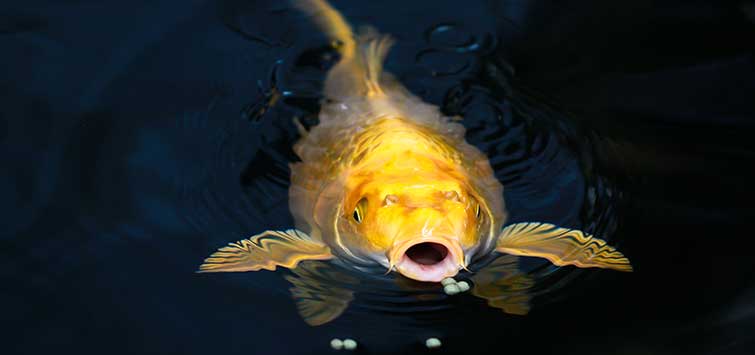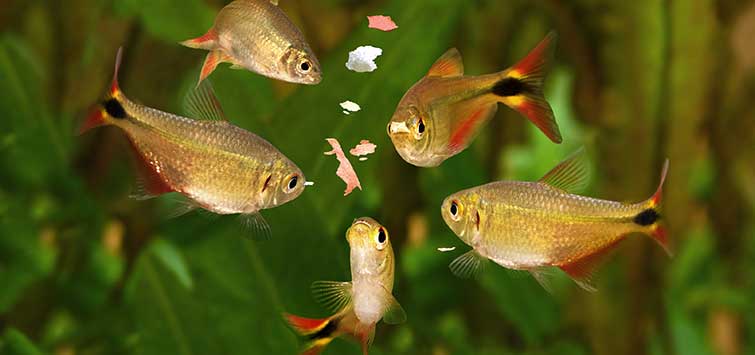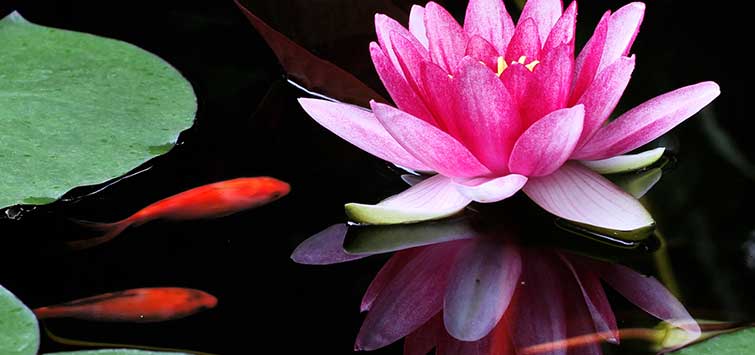Pond Foods and Feeding
Author: Maddy Hargrove
As with any species of aquarium fish, knowing what and how to feed your pond fish is essential to their health and well-being. Our author compares different types of food available and explains how to make feeding time fun time with your pond pets.
Lovely Ponds
Everyone loves pond fish. A tremendous amount of joy can be gained from watching koi, goldfish, and other pond species living happily in a naturalistic environment. And ponds are easier than ever to build and maintain with all the choices offered by manufacturers in today’s market, and many hobbyists who do not have the yard space, or don’t live in a climate suited to an outdoor setup, even build indoor ponds.
Putting together a pond these days is a snap, but if you want your fish to remain healthy and happy, you need to make sure they have all of their nutritional requirements furnished through a proper diet. There are a wide variety of foods to choose from, so it is time to take a closer look at how and what you should feed your aquatic pond pets.
Feeding Pond Fish
Fish in a garden pond can live on foods like plankton, floating pond plants, and the tiny roots of pond plants floating in the water, as well as the larvae of insects, worms, and other small animals. Unfortunately a natural food supply is not always perfect or abundant year-round, so your pond fish will need to be fed with commercial fish food. Feeding fish in the pond can be one of life’s greatest joys each day, when all of your fish surface from even the deepest levels of the water to eagerly feed.
There is no need to overfeed your pond fish simply because they are usually bigger than standard aquarium species, however. In fact, one day of fasting every week will help keep their digestive systems regular. Do not toss a ton of food into your pond, because that may leave leftover bits floating for a long time on the water. This will add unwanted nutrients into the water that can cause an increase in algae, as well as draw raccoons and other predators, and it will foul the water. If you know the basics, fish feeding in a pond can provide many hours of pleasure to both the young and old, and it will also offer an interesting glimpse into the lives of your aquatic pets.
Not All Foods Are Created Equal
When it comes to pond food, all the products are not the same. Manufacturers have recently taken great strides in producing foods that take into consideration your pond fish’s health, age, size, metabolic changes, seasonal changes, and spawning requirements. Pond fish need a balanced diet just like humans. If you ate nothing but steak every day, you would have problems; likewise, your fish will have problems if they eat the same thing without variation. To understand the basics of feeding, you need to know what your fish require in order to remain healthy and disease-free, and for them to achieve their maximum growth potential. Our pets always deserve the very best we have to offer, and pond fish are no exception.
Feeding Guidelines
One good rule of thumb for pond species such as goldfish and koi is to feed them once or twice per day an amount small enough so that they can quickly eat all of it. Make sure that your pets devour most of the food, and do not feed more than they can consume in a few minutes. Always feed your fish near the same area of the pond at a consistent time so they will come to you to eat. By doing this you will be able to regularly check your fish for disease and other problems as they happily munch away. As mentioned previously, it never hurts to avoid feeding them one day a week.
How Water Temperature Affects Feeding
Feeding should be maintained when the pond water remains between 50° to 85°F, but the food offered depends on where the temperature is in this range. When the water temperature drops below 50° to 55°F, the fish’s metabolism is too slow to utilize food. When the temperature soars above 85°, the fish’s metabolism also slows and dissolved oxygen in the water is extremely limited, so feeding should be reduced greatly.
Nutritional Requirements
A cold-blooded pond fish’s nutritional needs are quite different from humans, who are warm-blooded. People can use up to 60 percent of their food intake to regulate their internal body temperature. Fish are cold-blooded animals that do not need to generate body heat. Fish have another advantage over humans in the energy department. A fish’s body is supported by the water around it, so they do not need to deplete very much of their energy fighting off the natural effects of gravity. Thus, your pond fish do not need to feed while the water is cold. In fact, if they do feed when their digestive system is shut down, the food can putrefy in their gut and kill them!
As the water warms up in the spring, the fish will begin to feed, and they need an easy-to-digest carbohydrate-based diet. During the warmer months, pond fish require a high-protein diet for growth and spawning. Then as the water cools in the fall, they once again need an easy-to-digest carbohydrate-based diet.
Fish also need vitamins and trace elements, of course, and food that contains minerals and vitamins will help to strengthen the immune system of your fish and therefore increase their resistance against fish diseases.
Excellent Snack Foods and Vitamins
Spirulina algae, which is often found in fish food, is packed with nutrients and is a natural color enhancer. A balanced diet also includes vitamin B, vitamin C, and digestive enzymes that will help your pond fish stay healthy throughout the winter months. Experiments have shown that wheat germ will help goldfish and koi grow at a much more rapid speed, and it is also a natural source of vitamin E (a vitamin that helps with fertility). Vitamin E also improves blood circulation for increased oxygen and nutrient flow, helps to promote balanced growth, and aids in fighting off disease.
Brine shrimp are continuous filter-feeders that will fill their gut with almost anything that is small enough to be eaten, and this food is passed to your aquatic pets when they are consumed. Brine shrimp can deliver food and nutrients to your fish through this process, which is known as bio-enrichment.
Pond fish can sometimes be fed snacks such as fresh lettuce and celery bits as well. They will also appreciate small bits of fresh fruit, such as oranges and mangos. These types of fruits and veggies should only be offered occasionally, as they can easily cause the water to become fouled. Live insects are also greatly appreciated and will often be consumed as they fall into the water naturally, so be careful when using insecticides around a pond. You can buy insects from many pet stores and feed them to your pond fish as well. Some people place an electric bug zapper over the pond so that the insects drop into the water, much to their fish’s delight.
Manufactured Foods
As you can see, nutrition is a bit more involved than you might have thought, but what is in the pond foods we commonly see on the market? Manufacturers provide different types for the different seasons, so read the labels and follow the manufacturer’s recommendations.
Like aquarium fish foods, pond foods come in many varieties:
• Flake food will float on the surface and then sink slowly toward the bottom. It is good for feeding fish that swim at midlevel.
• Live food will help to increase spawning rates, encourage good growth, and maintain health.
• Granulated food is good for easy digestion during the winter months.
• Stick foods generally float and are good for fish that feed near the surface.
• Heavy pellet food is great for aquatic pond pets that like to skim the bottom.
• Occasional fresh fruits and vegetables make a healthy snack.
Diet Is Important
As you can see, pond foods vary greatly in content and purpose. Before you purchase food for your aquatic pets, you need to consider what their requirements are based on the time of year, temperature, age, and spawning cycles. One food will not cover everything, whether it is tropical fish or pond fish that you favor. It is always best to provide a varied and balanced diet so your fish can achieve the best health and vitality possible.
I have always reminded people that manufacturers are more than willing to answer any questions you may have concerning their food products. All it takes is a simple phone call to find out the information you need. After all, we are all in this hobby together, and I am confident that hobbyists and concerned manufacturers will continue to work together for the betterment of fishkeeping.
See the full article on TFH Digital http://www.tfhdigital.com/tfh/200905/#pg111

.png?h=595&iar=0&w=2781&hash=5FD5E69473BCC22199FBFA2FB71B6033)



